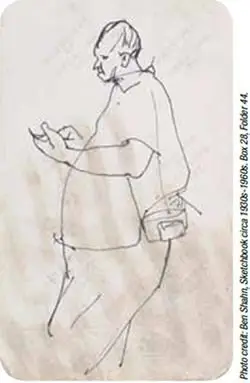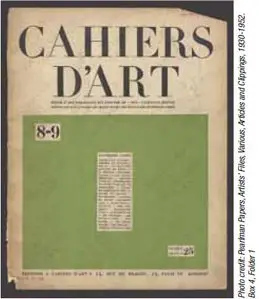Smithsonian Institution’s Archives of American Art
Capturing The History of American Art For Public Access
Client
The Smithsonian Archives of American Art (AAA)
Project:
Assist in the digitization efforts of the world’s largest repository of American art history by supplying a combination of capture hardware and conversion services
Statistics:
1.5M+ images from print, photographic and other media
Solution:
- In-house: purchase of capture hardware (microfilm and book scanners)
- Contracted conversion services: an estimated 500,000 images from four collections, primarily 300 dpi grayscale TIFF format
Equipment/Software In-house:
- Mekel Technology microfilm scanner with custom capture/ processing software
- Zeutschel 10000 A1 book scanner
- Zeutschel 10000 TT book scanner
- Zeutschel OmniScan with Perfect Book software
Contracted conversion services:
- Zeutschel OS 12000 TT A2 color scanner
- Zeutschel OS 10000 TT book/large-format scanner

Shahn, best known as a social realist.
Digitized on a Zeutschel overhead book
scanner utilizing PerfectBook curve correcting
software.
Founded in Detroit in 1954 by Edgar P. Richardson, then Director of the Detroit Institute of Arts, and Lawrence A. Fleischman, a Detroit executive and active young art collector, the initial goal of the Archives was to serve as a microfilm repository of archival papers housed in private hands and other institutions. This mission expanded quickly to include collecting and preserving original material. In 1970, the Archives joined the Smithsonian Institution.
Now housed in Washington, D.C., Archives of American Art (AAA) is the world’s largest and most widely-used resource dedicated to collecting, preserving and providing access to the primary sources that document the history of the visual arts in America. Nearly 5,000 archival collections contain: diaries and scrapbooks of artists, dealers and collectors; manuscripts of critics and scholars; business and financial records of museums, galleries, schools and associations; photographs of art, world figures and events; sketches and sketchbooks; rare printed material; and film and audio and video recordings. AAA also has the largest collection of oral histories anywhere on the subject of art.¹
Challenge: Access
Providing maximum access to the collections was – and is – key to achieving AAA’s goal of becoming the premier resource on art history for researchers, historians and the public. Richardson and Fleischman could never have imagined the advent of the internet and its power to connect people and information across the world. Today, housing over 16 million items at press time and with more than 1.5 million available in online collections, AAA has made significant progress toward this goal.*
AAA and The Crowley Company first worked together in the early 1990s when AAA purchased Mekel Technology microfilm equipment and, later, two Zeutschel A1 planetary book scanners to supplement their digitization efforts. Barbara Aikens, Chief, Collections Processing, notes that, “At the time, there really was no comparable scanning equipment on the market suitable for large-scale or mass digitization projects where the primary goal was online access. The Zeutschel scanners were a major contributing factor in AAA’s highly successful initiative for digitizing archival collections in their entirety.”
Challenge: Data Management
With equipment in place, one of the primary challenges for AAA was to build an interface and workflow system that could hold and easily manage a substantial database. As Aikens notes, “The Mekel and Zeutschel capture software and file management structures proved very compatible with our workflows and infrastructure.”
Challenge: Volume
As AAA’s volume of digitization increased, Crowley and AAA continued their partnership in another manner: contracted conversion services. Aikens states, “We needed to expand digitization beyond our in-house capabilities; particularly for very large collections. For our large-scale efforts, the combination of in-house scanning and contracted services gave us the highest productivity at the best price. Crowley was a logical partner due to their close proximity to the nation’s capital and the fact that they offered competitive pricing.” She continues, “I feel that Crowley understands that our large-scale digitization initiative is about volume and access. The goal of this project was – and is – about getting a high quantity of good quality digital images in a timely fashion so that we can make our resources more widely available and accessible on a global level.”

Sample Collections
Recent AAA Crowley Imaging conversion services projects include:
- An estimated 130,000 images from the Carnegie Institute Museum of Art collection
- An estimated 130,000 images from the Ben Shahn collection
- Approximately 6,500 images from the Pearlman collection
- More than 320,000 images from the Jacques Seligmann & Co. collection, one of AAA’s largest fully-digitized collections available online
Images have been scanned from multiple media including: letters; manuscripts; bound materials; photographs; fragile/onion skin materials; and some original sketches. Primarily using Zeutschel overhead scanners, Crowley Digitization staff were able to produce high-quality images regardless of the condition of the original material.
The Results
Through capture hardware and conversion services, The Crowley Company played a major role in assisting AAA reach its 2011 milestone of having 1.5 million digital images available online. AAA’s digitization initiative is now part of its long term mission, which has changed very little since the early vision of Richardson and Fleishman: to share and make available hidden archival treasures regarding American art.
Pat Crowley, company vice president, notes, “We appreciate the initiative of the Archives in managing their collections and have enjoyed being an integral part in their strategy.”
Ultimately, it is the end user who benefits from this partnership. As one example, the availability of the Jacques Seligmann & Co. archives has satisfied the needs of users across the world conducting World War II era art provenance research. The online collection has been referenced in several international-level symposia.
Three Decades Strong
Now entering a third decade of partnership, Crowley and the Smithsonian Institutions still continue to collaborate on digitization projects across their network of collections.
About The Crowley Company
The Crowley Company is a full-solution imaging partner. From micrographics equipment, production and patron scanners to conversion services, The Crowley Company has aided records managers, archivists, librarians, researchers, students and others throughout the world with archival preservation, records management and digitization solutions for over forty years.
Contact us for more information
¹Archives of American Art
*First printed in 2013

